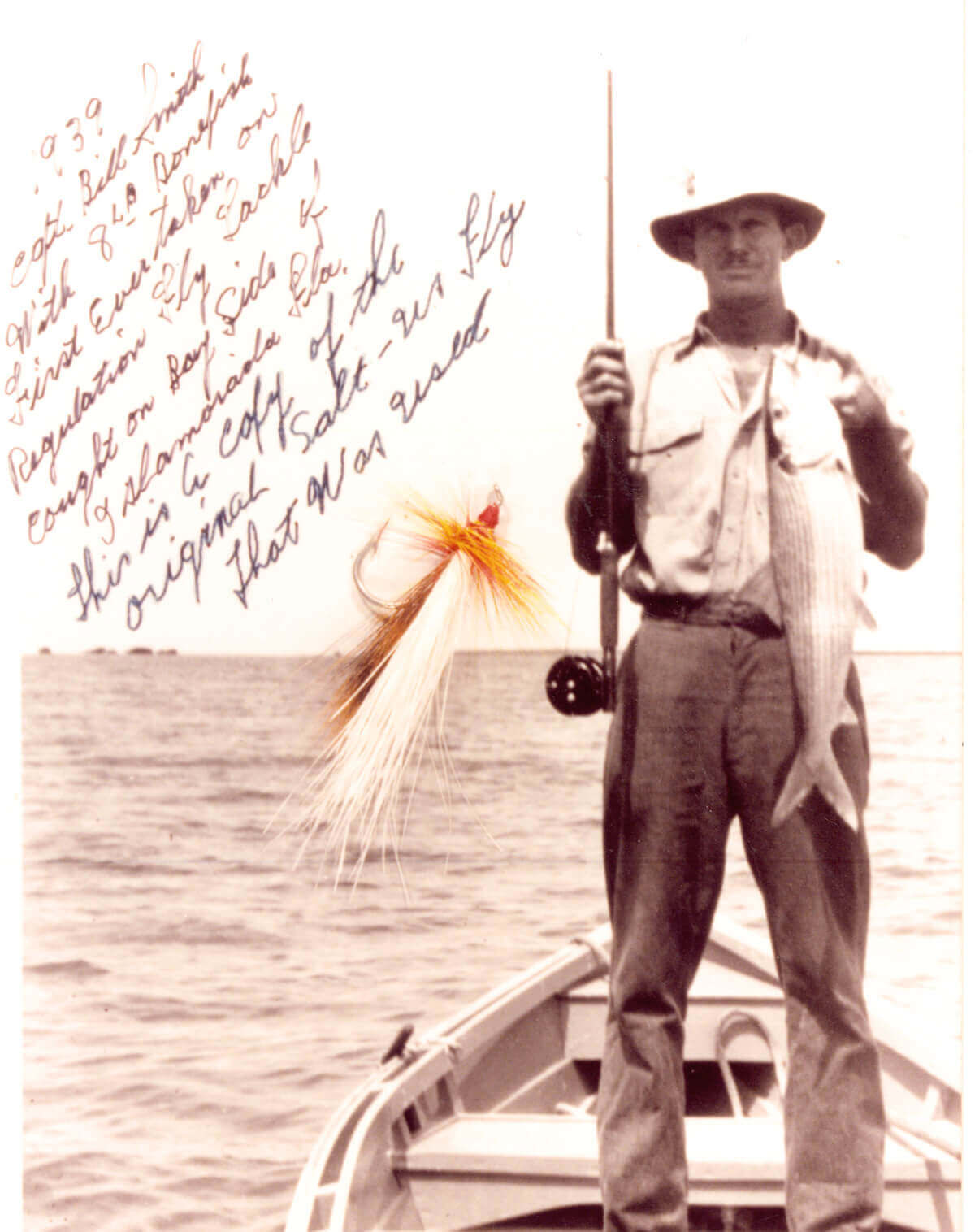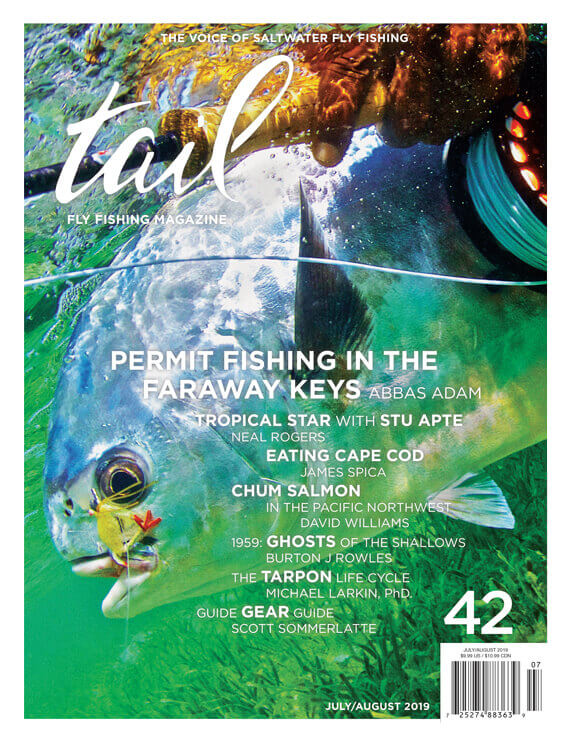Who Caught the First Bonefish on a Fly?
by Pete Barrett
Florida Keys guide and fly fishing pioneer Bill Smith is popularly credited with catching the first bonefish on a fly in 1939. There’s a photograph and witnesses to prove it. I’ll tell you the full story of Bill’s catch in a moment, but first we need to acknowledge several other fly anglers who accidentally beat Bill to the punch—but because they weren’t specifically targeting bonefish, their catches didn’t qualify as numero uno.
It seems all of the earliest on-the-fly bonefish catches were made by accident when anglers were fishing for snapper, snook, or baby tarpon. Because of their low-slung mouths, fly fishers of the 1920s and 1930s thought of bonefish as bottom feeders (true) that would only respond to bait (untrue), and so no fly anglers fished specifically for bonefish. It took about 20 years for the bonefish’s keen eyesight to be recognized and appreciated.
“LaBranche looked
incredulously at the
pork rind fly and
went into a tirade…”
According to George X. Sand in his book Salt-Water Fly Fishing, Holmes Allen of Miami caught a bonefish on the fly in 1924 in Card Sound, Key Largo. Allen said he was wading with a friend for snook about 100 yards from shore when “…this crazy fish shot out of nowhere, grabbed my fly and took off!” The fly was a crippled minnow feather streamer with a white head and red hackles, tied on a size-2 hook. Allen caught another bonefish in 1926.
George Reiger in [italics] The Bonefish, [italics] his wonderful historical tribute to the gray ghost, documents that in 1926, Colonel L.S. Thompson of Red Bank, New Jersey, caught bonefish while casting a Royal Coachman streamer for baby tarpon on the flats near the Long Key Fishing Club. Other club members apparently did, too, but always as an incidental catch.
Noted naturalist and South Florida fly fishing trailblazer Homer Rhode Jr. wrote to angling author J. Edson Leonard in 1949 that he had been catching bonefish for 15 years. That would put Rhode’s first fly-caught bonefish at about 1935. Rhode even created a special fly about which Lee Wulff would write, “The best fly I know for bonefish is the Homer Rhode Shrimp Fly.” It’s not known whether Rhode was sight-casting to bonefish or simply catching them by accident while he cast to other fish.
Let’s get back to Bill Smith’s bonefish and a humorous confrontation with George LaBranche, one of the premier anglers of the 1930s and a resident of Islamorada. In 1938, while guiding George Crawford, an accomplished fly angler from Alaska, Smith struck out on baby tarpon. Feeling bad for his client, Smith asked a fellow guide, Leo Johnson, what he used to catch tarpon. Johnson’s “flies” were nothing more than a strip of pork rind wired to a hook, but this got Bill Smith to thinking. That night, in preparation for the next morning’s charter, Smith tied a simple white bucktail with a piece of wire attached to the hook to hold the pork strip. Hoping to catch a tarpon, George Crawford cast Smith’s fly, with a trace of pork added, and proceeded to catch two bonefish!
The elated men placed the bonefish in a gunny sack and weighed them at the local Islamorada grocery store; the fish weighed 5 and 6 pounds. While the men were congratulating themselves, George LaBranche entered the store and asked about the fish in the sack. Smith proudly told him that they had caught a pair of bonefish on flies. LaBranche inspected the fish and then asked to see the fly, which Smith promptly showed him. LaBranche looked incredulously at the pork rind fly and went into a tirade, thoroughly upbraiding Smith because it wasn’t a “real” fly of hair and feathers.

Bill Smith’s legendary catch proved that bonefish could be cast-to and caught with the proper fly and retrieve—not simply by accident as was previously believed through the 1920s and ‘30s. Notice his fly, tackle, and boat—a far cry from what’s popular today. Thanks to Gail Morchower at the International Game Fish Association library for providing the photo.
Several months went by. Smith, still stinging from LaBranche’s reprimand, proceeded to tie some flies and went out alone in his outboard skiff to a favorite spot known as Little Basin, behind Islamorada. He cast to several fish, hooked one, played and netted it just as another guide, Bert Pinder, was heading to a nearby dock. Anxious to have someone witness the catch, Smith quickly followed Pinder to the dock to have him inspect the still-breathing bonefish and the regulation fly as evidence. A photo was taken of Smith holding the 8-pound bonefish, along with the fly rod and single-action fly reel he had used. Days later the photo appeared in a Miami newspaper, and this fish became acknowledged as the first bonefish specifically caught on a fly—not by accident, but by casting directly to the fish.
Years later, in an interview with Bill Sargent, a noted Florida outdoor writer, Smith said he “…remembers that the fly had a yellow hackle, was tied on about a 1-0 hook.” He named it the fly Salt-Us after one of his regular clients, a Mr. Saltus. The tying recipe included white bucktail and brown squirrel tail for the wing and a palmered yellow saddle hackle secured with red thread. Smith’s tackle was an 8-1/2-foot Orvis Battenkill rod, a Shakespeare model 1891 Russell reel, and an Ashaway GAF tapered fly line.
Sand’s Salt-Water Fly Fishing relates another interesting fly-caught- bonefish story that took place in 1942, just after the attack on Pearl Harbor. Clarence “Barrel” Bowen, a good friend of Bill Smith’s, was about to be shipped overseas, and he asked Bonnie Smith, Bill’s wife, if she’d take him out to catch a bonefish on a fly, as Bill had. Bonnie had assumed her husband’s guiding duties while he was away supporting the war effort, and she took Bowen to a good bonefish spot. She later recalled, “We were back at the dock within two hours and Barrel Bowen had taken his first bonefish with a fly rod.”
“We were back at the dock
within two hours and Barrel Bowen
had taken his first bonefish
with a fly rod.”
During the war, Bonnie Smith guided another young soldier, Jimmie Albright, and made it possible for him, too, to catch his first bonefish. Bonnie introduced Jimmie to her sister, Frankee, whom he married. With Bill Smith’s help, Jimmie became a legendary Florida Keys guide, and it was Albright who guided Joe Brooks to what is believed to be the first fly-caught tailing bonefish. That was in 1949. The following year, while fishing with Frankee Albright, the great George LaBranche chalked up his first official fly-caught bonefish (with Joe Brooks in the skiff as a witness). In 1950, Bonnie Smith guided Joe Brooks to his first permit on the fly.
Accidentally or on purpose, these early bonefish catches are all remarkable, and they helped to usher in the ‘bonefish age” of the Florida Keys. By 1950, new faces like Ted Williams, Stu Apte, George Hommel, and J. Lee Cuddy brought increasing fame to this astonishing gamefish, which continues to this day.
Writer’s Bio:
Pete Barrett has been fly fishing in salt water since the 1960s. He was a charter boat skipper for 30 years, and he was on The Fisherman magazine’s editorial staff from 1973 until his retirement. Pete has published over 1100 magazine articles and is the author of five popular books on angling. Pete is a Florida representative for the International Game Fish Association, and he’s currently an active member of the Atlantic Salt Water Flyrodders and the West Palm Beach Fishing Club. Pete lives in Jupiter, Florida.

 SUBSCRIBE TO TAIL
SUBSCRIBE TO TAIL